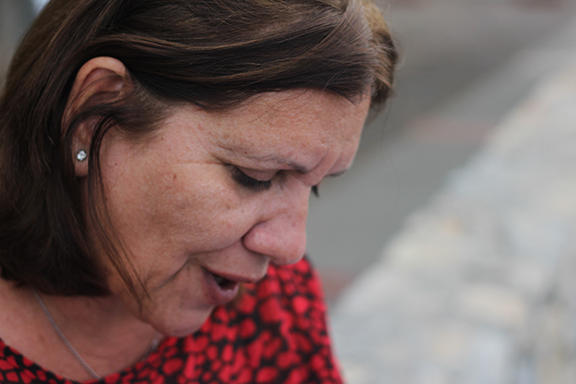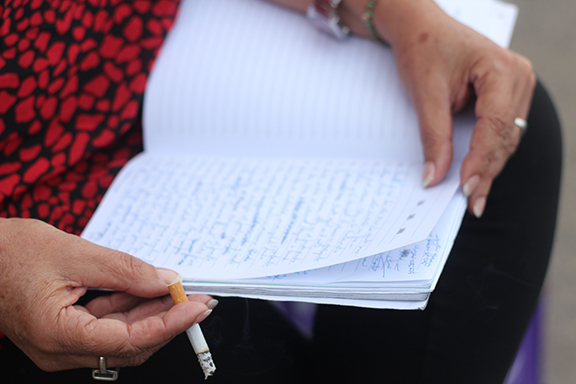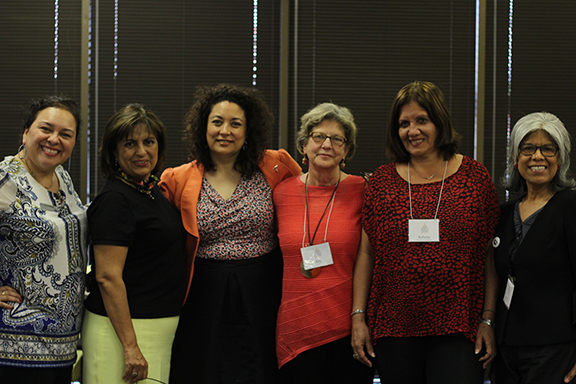On a sunny afternoon last March, Cuban journalist Rafaela Balanza Recasen made an unusual visit to the borderline that separates El Paso from Ciudad Juarez.

Rafaela Balanza reading from her journal. Photo credit: Antonio Villasenor-Baca
As the 57-year-old television journalist stood facing the border wall at Sunland Park, New Mexico, she fell silent and reflected on the dangerous journey that has driven many of her countrymen to flee the island and make their way through Latin America to reach the U.S.-Mexico border.

Balanza holding her journal and a cigarette. Photo credit: Antonio Villasenor-Baca
“It is an infinite wall. I approach and sink my feet into the fine sand… The silence is all pervading. The blue sky seems ironic. I am standing at the line where hundreds of Cubans have arrived over the years… risking everything for a dream, the American dream. I feel my chest constrict. I imagine them crossing the wall. I also imagine those who were not able to cross to reach the earthly paradise. I feel cold. At the same time, my hands sweat. I think of the thousands who weren’t able to make it. Those who died in the effort.”
Balanza said the primary purpose of her one-week trip to the border region this spring was to increase people-to-people understanding and communication between her countrymen and U.S. citizens, and was part of former President Barack Obama’s easing of travel restrictions and improving relations between the U.S. and Cuba.
The people-to-people trips are now at risk, however, after President Donald Trump announced this summer that the people-to-people visits are no longer permitted, U.S. citizens that visit the island can no longer use services tourist services such as hotels that are operated by the Cuban military.
Most recently there was a further set back in relations between the two countries when the U.S. scaled back personnel at the U.S. Embassy in Havana and later sent home most employees at the Cuban Embassy. The actions were in response to an unspecified and unexplained sonic attack that is believed to have injured some U.S. embassy employees in Havana. The Cuban government has denied responsibility for the incident.
As part of her visit to the borderland, Balanza was invited to present a paper on the role of Cuban women in media at UTEP’s annual International History Conference on Gender Violence.
“I saw in her eyes, in her smile, and in her kind gestures how special this encounter across borders was for her and for us here at UTEP, “ said Associate Professor of Anthropology Dr. Guillermina Gina Núñez-Mchiri, who organizes the gender violence conference.
The conference provides opportunities for scholars and professionals to present on women and gender-related topics in their fields,” Nunez-Mchiri said. It’s purpose is “to create space for local, national and international scholars to join us an inter-disciplinary and cross-generational exchange of knowledge, experiences, and efforts,” she added.
Maria Lorena Sosa, a graduate student at UTEP now in her second year in the Bilingual MFA Program, attended Rafaela’s lecture to “learn more about the content in entertainment in a communist government, and sexual education.”

Balanza at her Women's History Conference presentation. Photo credit: Antonio Villasenor-Baca
In her written presentation at the conference, which was in Spanish, she noted that women in Cuba currently make up 48 percent of the nation’s parliament, 81 percent of those working in education and the sciences, 46 percent of people working for state governments, and 63 percent of university graduates.
At the same time, she said that when it comes to “gender equality” in Cuban society “prejudices and stereotypes remain” and “patriarchal values still place women in reproductive roles and spaces.”
The role of women in Cuban media, she added, was identified at the 1995 Beijing World Conference on Women as one of 12 priority areas that Cuba needed to work on to achieve gender equality.
Since then, many university researchers in Cuba have studied the role of women in news media and concluded that most state-owned media does not have a strategy or plan for addressing gender equity and, in fact, “emits messages that reinforce and disseminate attitudes, images and information that is discriminatory.”
At the same time, feminist-oriented publications like the magazine “Mujeres” is producing content that is “not traditional, flexible, open to differences and respect for every human being.”
Balanza acknowledged that pop culture in Cuba, like in the U.S. and other countries, sexualizes women and reinforces traditional stereotypes of women as sexual objects or mothers.
She provided an example by showing a Reggaeton music video produced in Cuba that shows scantly dressed women on top of 40’s and 50’s era cars dancing and making suggestive dance moves. She presented another example of how traditional news media tries to address women’s issues––a public information video that tackles misconceptions about the role of women in society, such as machismo and family violence.
Here, she said, people are constantly on their cell phone and seem to keep to themselves. “I see so many young people, so many young women, and I still haven’t seen a couple in love together,” she noted, and mentioned that the city seems “monotonous” because it consists mainly of, “buildings, buildings, freeways, cars.”
Her overall impression of borderland culture: “It’s a struggle between two cultures, between McDonald’s and tacos, between whiskey and tequila, between Labradors and Chihuahuas.”
Without using labels like Fidelista or Communist to describe her country, Balanza said she wants the world to know the “real” Cuba. The island is still under a U.S. economic embargo imposed after the Cuban revolution of 1959, although recent U.S. governments have lifted some trade restrictions and softened the travel ban for citizens and residents under certain conditions.
“Cuba is the thorn in the side, the pebble in the shoe… because of its resistance, for enduring many years and having made it independently,” Balanza said. “They have wanted to get rid of what we have shown the world.”
But, she added: “Like the Cuban song says––aquí estamos, here we are.”

